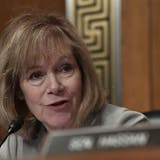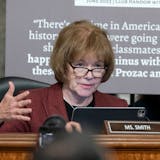DFL Rep. Angie Craig rode the 2018 blue wave to victory and has fended off close challenges for the last three terms by appealing to a broad swath of swing voters in the Second Congressional District.
All of her races have been close, but her tightest race so far was during the 2020 presidential election when she beat GOP Tyler Kistner by just over two points. Running in a presidential election year once again will put Craig’s mainstream appeal to the test and could determine whether the Second Congressional District remains one of the last swing seats in the state.
A majority of district voters have picked the winning presidential candidate each cycle since 2000. Some people describe them as independents, but Joe Atkins, a Dakota County commissioner from Inver Grove Heights, prefers “zig zaggers.”
“They work their way down the ballot and vote for people depending on whether they show up on bread and butter issues” like public safety, transportation and the economy, said Atkins, a former House DFLer. “It’s more about the candidate than the partisan leaning. It’s trended more blue, in recent years, but a Republican can definitely win in CD2.”
Craig will face off against GOP political newcomer Joe Teirab in November. He’s a former assistant federal prosecutor and Marine who hopes to turn out Republicans and convince those “zig zaggers” to give the Republican candidate a fresh look. Both candidates have considerable campaign war chests and backing from national groups.
But would a fourth-term win for Craig indicate the district is trending blue? The answer is not straightforward. Political observers think the district will remain a swing seat for the foreseeable future.
“I think we could see that over the past few elections it’s trending blue. It’s just still so close to 50/50,” said State Sen. Erin Maye Quade, DFL-Apple Valley. “It’s not that long ago that we had a Republican member of Congress and some really hard-fought elections.”
Craig became only the second Democrat to hold the seat since the 1940s when she beat former Rep. Jason Lewis in 2018 by over five points in a rematch. And the race between Craig and Kistner was decided by 9,580 votes and by a little over 17,000 votes in their 2022 rematch.


